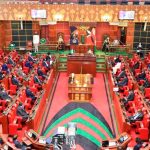Government Ministries, State Departments and Agencies (MDAs) have until August 15 to to submit their annual asset reports to the National Treasury.
Prime Cabinet Secretary, Musalia Mudavadi has said the 19th performance reporting cycle has come to end and there will be no extension for MDAs yet to submit their reports.
In a speech read on his behalf by the Principal Secretary State Department for Performance Management and Delivery Services, Ann Wang’ombe Mudavadi stated that National Treasury is operationalizing assets module in Integrated Financial Management Information System (IFMIS).
This is expected to provide a real-time automated platform of capturing Government assets data and reporting on assets using the prescribed templates.
He spoke when he officially opened the principal secretaries’ sensitization workshop on fiscal reforms on asset and inventory management in Government at the Kenya School of Government in Nairobi.
“As accounting officers, you will have tracking dashboards. To protect you against unnecessary apprehension, adequate resources for implementation have been allocated for these overdue fiscal reforms. We are ready for the reform agenda, so should you be,” said Mudavadi.
According to Mudavadi, the current manual inventory management has inefficiencies that limit visibility and control of inventory levels, is time consuming, prone to human errors and prevents the optimal use of human resources.
To achieve the goal of maximizing value of Government investments, he said National Treasury has initiated fiscal reforms to automate assets and inventory management in MDAs and in County Governments.
He stated that the fiscal reforms will be pursued in line with the Governments’ Bottom-Up Economic Transformation Agenda (BeTA).
” For avoidance of doubt, the reforms are in tandem with our resolve to automate all Government processes and services, key among them, the management of public assets,” he affirmed.
Mudavadi reiterated to that digitilisation of public financial management processes is a key component of cost saving reforms meant to protect public resources from malefascence by increasing efficiency and enhancing service delivery.
He also said the changes provide for real-time tracking of inventory levels and enhance supply chain management practices.
” Importantly, the changes improve decision-making through data mining and analytics. The decision to pilot these reforms in the Executive and National Treasury, before being roll-out to MDAs, shows the level of Government commitment to see this process through,” he stated.
He also affirmed to the Principal Secretaries that Government policy stance on fiscal reforms is clear and anchored under the policy on asset and liability management in the public sector. Similarly, he noted that statutory and non-statutory reports to oversight institutions on assets and inventory administration and management, should be geared towards enhancing optimization, transparency and accountability of public assets while supporting decision-making at the top management.
“I hope you do not feel overwhelmed by what is demanded of you. Implementing reforms is part of the responsibility you undertook to serve Kenyans,” he told the PSs.
He added that the fiscal reforms are a precursor to full adoption of accrual accounting in the public sector, a key pillar in ongoing public finance management reforms.
“The purpose of these fiscal reforms should be a boon to accounting officers. You will have a bird’s eye view of all inventory and assets under your control, while facilitating optimal assets and inventory utilization. The reforms will also help you address the perennial concerns by the Auditor General about inadequate management of Government assets,” Mudavadi explained.
To ensure these fiscal reforms are given the serious stimulus required, asset management is included as one of the key performance indicators in the 20th performance reporting cycle.
Henceforth, MDAs are required to ensure proper management and disposal of Government assets under them.
Fiscal reform requires adequate asset management structures are in place to ensure prudent management of public assets, with National Treasury expected to continue prescribing to efficient and effective but automated, simple and easy-to-understand and use, public finance management systems.
He also said the National and County Assemblies’ oversight role is being and enhanced and Kenyans will benefit even more from certainty in administration and management of their assets.



